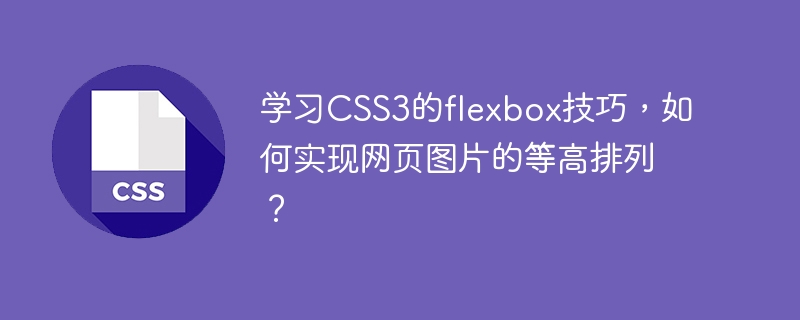

Learn CSS3 flexbox skills, how to achieve equal height arrangement of web page images?
In web design, we often encounter situations where pictures need to be arranged at equal heights. The traditional method is to set a fixed height for each image, but this is not only cumbersome but also inflexible. Especially in responsive design, the height of the image may be different under different device sizes. The flexbox layout in CSS3 provides a simpler and more effective solution.
1. Introduction to flexbox
Flexbox layout is a new flexible box model added in CSS3, which can simplify the layout and alignment of web page elements. By controlling the properties of containers and child elements, flexible web page layouts can be achieved. In flexbox layout, the container is called flex container and the child elements are called flex items.
2. Flexbox layout to achieve equal height arrangement of pictures
The following takes a simple grid gallery as an example to introduce how to use flexbox layout to achieve equal height arrangement of pictures.
HTML structure:
<div class="grid-container"> <div class="grid-item"><img src="/static/imghw/default1.png" data-src="image1.jpg" class="lazy" alt=""></div> <div class="grid-item"><img src="/static/imghw/default1.png" data-src="image2.jpg" class="lazy" alt=""></div> <div class="grid-item"><img src="/static/imghw/default1.png" data-src="image3.jpg" class="lazy" alt=""></div> <div class="grid-item"><img src="/static/imghw/default1.png" data-src="image4.jpg" class="lazy" alt=""></div> </div>
CSS style:
.grid-container {
display: flex;
flex-wrap: wrap;
}
.grid-item {
flex: 1 0 200px;
margin: 10px;
}
.grid-item img {
width: 100%;
height: auto;
}First, set the container containing the image to a flex container by setting display: flex Turn on flexbox layout. Then, set flex-wrap: wrap to achieve automatic line wrapping, so that the image can be automatically wrapped and displayed when it exceeds the width of the container.
Next, set each picture element to a flex item, which can be controlled using the .grid-item class. In this example, we set a fixed width (200px) for each flex item, using flex: 1 0 200px to indicate that the flex-grow attribute is 1 (that is, the proportion of the remaining space allocated), The flex-shrink property is 0 (i.e. no shrinkage is allowed), and the flex-basis property is 200px (i.e. the initial width is 200px).
Finally, control the style of the image by setting the .grid-item img selector, set the image width to 100% to adapt to the width of the parent container, and set the height to auto to maintain The proportions of the image are not distorted.
Through the above style settings, the pictures in the grid gallery can be arranged in equal height. No matter what the height of the image is, it will automatically adapt to the height of the container and maintain equal height display.
3. Compatibility considerations
It should be noted that flexbox layout is well supported in various modern browsers, but there may be compatibility issues in some older versions of browsers. . You can use tools such as Autoprefixer to automatically generate style prefixes that are compatible with various browsers to ensure normal display in different browsers.
Summary:
By learning the flexbox skills of CSS3, we can easily achieve equal height arrangement of web page images. Using flexbox layout, we no longer need to set a fixed height for each image. By simply setting flexbox related properties, we can flexibly achieve the effect of equal height arrangement under different device sizes.
I hope the introduction in this article can help you better apply flexbox layout in web design and achieve a more flexible and beautiful image arrangement effect.
The above is the detailed content of Learn CSS3 flexbox skills, how to achieve equal height arrangement of web page images?. For more information, please follow other related articles on the PHP Chinese website!